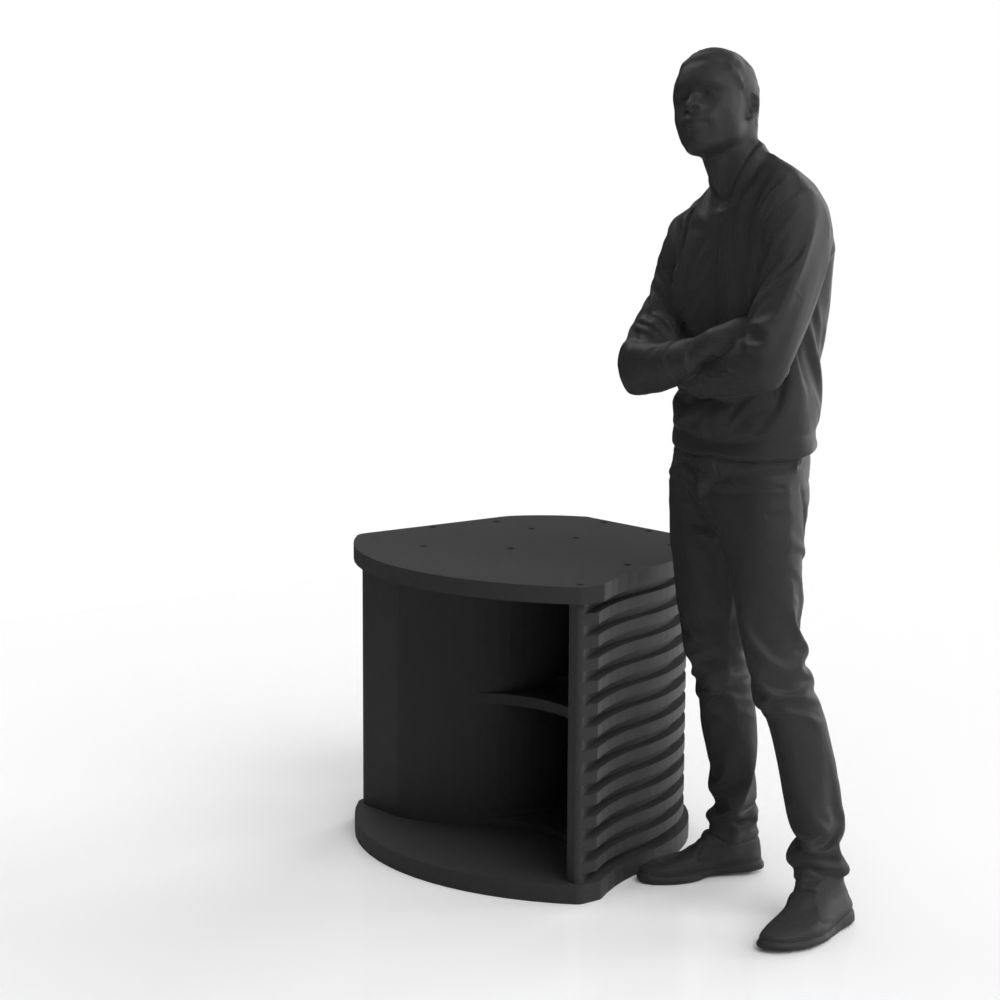In this blog post I would like to feature full objective test data on the Mid-Bass Horn Cabinet No.1274.
1274 includes the following features:
- Dual B&C 12PE32 per cabinet
- 109dB sensitivity @ 1watt (4v)
- 16ohm nominal impedance
- 110Hz-450Hz ±2dB
- Compact folded design
- 100dB Maximum SPL (Less than 0.30% Intermodulation Distortion)
- 110dB Maximum SPL (Less than 1% Intermodulation Distortion)
- 120dB Maximum SPL (Less than 10% Intermodulation Distortion)
Construction
The 1274 mid-bass is constructed from 27 layers of 24mm thick baltic birch plywood. Each layer is CNC machined and assembled with threaded rod. The top and bottom layers are constructed from 50mm thick solid walnut. Each of the two drivers are housed in a 25 liter sealed chamber. Each driver faces directly down the horn throat. The horn profile is designed carefully in using hornresp horn simulation software. CNC cutting was done on my CNC and only required basic 2-axis machining.
Physical Dimensions
Below is a general assembly drawing of the 1274 mid-bass cabinet. The ES-290 Biradial is positioned at an 840mm (33") listening height while the ES-1200 Biradial is positioned at a 1030mm (40.50") listening height.
Below are some render images:




Construction Photos
Below are some photos of the construction process. Please note this images are not of the finished product. The photos don't show walnut top/bottom plinths or sanding or staining.


Below is the horn dry assembled for testing purposes, unstained and without the walnut top/bottom plinths. My projector remote control is shown for scale. The subwoofer drivers on the left of the photo are 15".

Objective Test Data
Frequency Response
Below is the frequency response. I'm getting ±2dB from 110Hz - 450Hz. Above 450Hz we see a gentle 12dB/octave falling response. Below 110Hz we also see a 12dB/octave slope although is falls a little steep just below 110Hz. Please note that these measurements were taken in my studio with the mic placed at 30cm from the horn mouth. I did not gate the frequency response so I am likely getting some room interaction causing some peaks and dips in the response.

Step Response
The step response is generally well behaved.

Burst Decay
The burst decay shows nothing significant in terms of resonances. The vertical scale has been increased to -35dB to highlight performance.

Impedance Sweep
Below is the impedance sweep. The fundamental system resonance is 56Hz. The rear chamber is 25 liters for each driver. This keeps the FS an octave below the Fc (Horn cutoff frequency) for a flat phase response across the horn's frequency bandwidth (110Hz-450Hz).

Harmonic Distortion
Below is a harmonic distortion sweep at various SPL levels. Generally the mid-bass horn achieves HD levels well below 0.1%. I placed my mic right at the horn mouth which caused a slight falling response past 200Hz.
Harmonic Distortion 90dB SPL @ 1 meter shown below:

Harmonic Distortion 95dB SPL @ 1 meter shown below:

Harmonic Distortion 100dB SPL @ 1 meter shown below:

Intermodulation Distortion
Below is the intermodulation distortion sweep. I conducted the sweep at 100dB SPL at 1 meter. For the sake of comparison I've directly tested against a well regarded 15" mid-bass (RCF L15-554K). My mid-bass cabinet has about 50% less IM distortion than the RCF Mid-bass driver. It should be noted as well that the RCF uses copper shorting rings to reduce IM distortion while the 1274's B&C 12PE32 drivers do not. It stands to reason that the 1274 mid-bass could see even better IMD figures if using drivers with copper shorting rings.
As a side note, low intermodulation distortion is strongly correlated to perceived clarity (1, 2).
References
(1) Newell, P. (2017) Recording Studio Design (4th Ed) Routledge
(2) Voishvillo, Alexander, ‘Assessment of Loudspeaker Large Signal Performance – Comparison of Different Testing Methods and Signals’, presented at the 111th Convention of the Audio Engineering Society, Contribution to the Task Group SC-04-03-C, New York, USA (December 2001)


